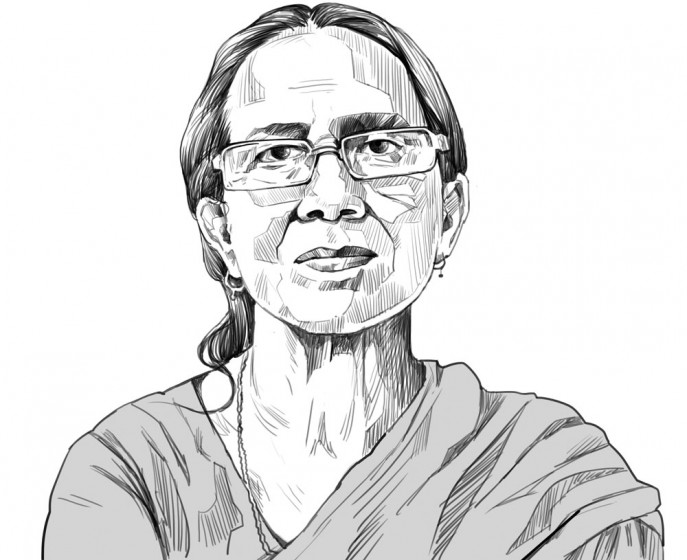A serious lacking in women’s movement globally is the inability to include the environment as the most critical and urgent feminist concern, even though many of the leading global environmental activists are women. For Bangladesh, this is more true since climate disasters are hitting the country more than other geographical regions to the extent that the environment now is the most critical existential concern.
More so now, since there has hardly been any gain in the Glasgow COP26. We can hardly hope for any global reduction in carbon emissions. After the COP 26, the environment must be the priority of the women activists of Bangladesh and for the women’s movement.
The commitment to resist environmental disasters will increasingly be the indicator by which our commitment to the cause of women might be measured. To see women through the mainstream ‘gender equality’ lense is not enough. The conventional policy framework links gender equality with enhanced environmental outcomes; for example, it is argued, when gender inequality is high, forest depletion, air pollution and other measures of environmental degradation are also high. Therefore, to achieve SDG goals in any substantial way, attention to gender equality is expected from governments.
There is a much-repeated common sense argument that countries with more women in their parliaments are more likely to set aside protected land areas and ratify international environmental treaties. The outcome of the Glasgow Cop 26 drastically reduces the credibility of these claims, since the global polluters hardly care about what is happening to the people on the ground, particularly to women.
Women are going to suffer badly in the coming years. What I am arguing is not to reduce gender merely as a means to achieve environmental goals. I strongly propose that women must be the active agent of change since they have the highest stake in the destruction of the environment, ecology, biodiversity and livelihood.
In Bangladesh, women are the worst sufferers of cyclones, oceanic surges, degradation and pollutants in land and water bodies, deforestation etc. For women, pesticide is a very critical concern. It is well known that exposure to certain agricultural and industrial chemicals, and organic pollutants increase women’s vulnerability during pregnancy and childbirth. In a study conducted in 1993 for the World Health Organization, researchers in Sudan found that 22% of hospital stillbirths were linked to expectant mothers’ pesticide exposure.
In Bangladesh, pesticide use is rampant, but we don’t even have the slightest idea how women, particularly rural women, are affected by the use of pesticides and herbicides. There are several micro-studies but at the national level, there is a lack of gender-differentiated morbidity data. Pesticides are major means of committing suicide. After the ban of WHO Class I pesticides in 2000, the number of mortality from suicides reduced from 15.1% to 9.5% in Bangladesh. This is from research done in Bangladesh based on the available hospital data.
Not only the pesticides, roads are built in the villages without any assessments of whether these may cause waterlogging and affect women’s lives. There are about 353,000 km of rural roads in Bangladesh according to the Local Government Engineering Department (LGED) sources. These roads connect the villages with union, upazila and zila headquarters, important market centres and national roads and highways. This sounds very good and is a sign of development. So undoubtedly the need for constructing such roads cannot be denied. But the problem is that those who plan for the roads do not take into consideration the effects on the paddy, as well as the crop fields.
Waterlogging has become a serious environmental concern predominantly in some parts of the southern districts of Jashore, Satkhira and Khulna districts and also in other districts of Tangail, Pabna for the last two decades. These areas have faced rainfall-induced floods and prolonged waterlogging due to the slow discharge of water in the embanked areas. With climate change, there are excessive monsoon rains and also flooding from the rivers. Due to inadequate drainage through the roads and embankments, the crop fields are inundated and cannot be drained for months after the monsoon. I have seen farming women trying to clear the water hyacinth that comes with water and become a menace for the crops. The blessing of the monsoon rain becomes a curse for the farmers; resorting to depending only on sunshine to dry the water up so that they can cultivate the land. No actions are taken by the local authorities for draining. Women are desperate to tackle waterlogging but without drainage, nothing can be done.
It is good to see that environmental groups, with many women leaders, are active against river pollution and illegal occupation of land destroying hundreds of rivers of the country. Bangladesh is a riverine delta, having over 1500 – 2000 small and big rivers; although the government records show only 440 rivers. That means the drying of rivers is not even in the records of the government. Road and highways and the big bridges become icons of ‘development’, but the life and livelihood of thousands of women living on the rivers as fishing communities, farming or part of boatmen’s family, or the farming communities might have been affected severely. No statistics on displacement has ever been published with gender disaggregation. The socialisation of women to and from their parents’ homes through waterways has changed; they have to take a longer route through roads by buses. The river pollution and illegal occupation led to the destruction of the occupation of the fishing communities.
Women’s movements have strong environmental concerns and directly or indirectly support a movement that upholds environmental rights. Environmental disasters cannot be ignored anymore because it affects the life and livelihood of people of all classes. The movement, therefore, is growing at grass roots to the national level. Many women activists are part of these environmental movements, but there is a separation between women’s movements which remain confined to only “women’s biological being” with the primary focus on individual rights. Rethinking human beings as integral to nature and constitutive of the planet is a great intellectual and political challenge. We are not entities external to the planet.
These are not difficult to understand, but it is not easy to free ourselves from the egocentric framework of the mind. We need to break the divides between individual and social.. Similarly, we need to break the boundary and limit between our biology and planetary existence.
Therefore, movements for women’s rights are necessary and urgent while the task is to transform our vision and objectives. Learning to cultivate individual agency into collective force is where we need to concentrate to overcome the present lack. We need to achieve rights to education, right to work, income, property. More so now in Bangladesh is the right to speak, organise, protest and vote.
Unfortunately, the women’s movement, concentrated more in the cities, fails to see the real issues of the majority of women of the country who are affected by different forms of recurring environmental and ecological disasters. Environmental disasters as a source of women’s deprivation has hardly been understood by the elite-led women’s movement.
It is time to change our priorities.
Farida Akhter. Sketch: TBS
“> 
Farida Akhter. Sketch: TBS

